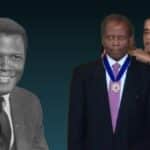Samuel Lay (March 20, 1935 – January 29, 2022) was an American drummer and vocalist. From the late 1950s, the blues and R&B musician Samuel Lay played alongside Bob Dylan, Little Walter, Howlin’ Wolf, Paul Butterfield Blues Band, and many others. He was inducted into the Rock and Roll Hall of Fame in 2015. He died at age 86 of natural causes in Chicago; the Alligator Records posted Monday, January 31 31.
Lay, known for wearing a cape and carrying a walking stick, was inducted into the Rock & Roll Hall of Fame in 2015 as part of the Paul Butterfield Blues Band.
“Words can’t describe it if you like blues as I do,” Lay told the South Bend Tribune that year, referring to the band. “I enjoyed the moment of it, and everybody that was in that band, I enjoyed. I learned a lot from everybody in there, and they claim they learned a lot from me.”
Alligator Records said Lay was known for his “trademark, hard-to-copy ‘double-shuffle'” drumming, based on double-time hand-clapping in his childhood church.
Lay, a native of Birmingham, Alabama, played professionally in Cleveland in the mid-1950s before moving to Chicago, the record label said.
In 1969, he played drums on “Fathers & Sons,” Waters’ best-selling record on Chess Records.
Lay backed up Dylan on drums in 1965 at the Newport Folk Festival. It caused a stir in the crowd because Dylan played an electric guitar and had turned to a rock sound.
Alligator Records said Lay was known for his “trademark, hard-to-copy ‘double-shuffle'” drumming, based on double-time hand-clapping in his childhood church.
Lay, a native of Birmingham, Alabama, played professionally in Cleveland in the mid-1950s before moving to Chicago, the record label said.
In 1969, he played drums on “Fathers & Sons,” Waters’ best-selling record on Chess Records.
Lay backed up Dylan on drums in 1965 at the Newport Folk Festival. It caused a stir in the crowd because Dylan played an electric guitar and had turned to a rock sound.







